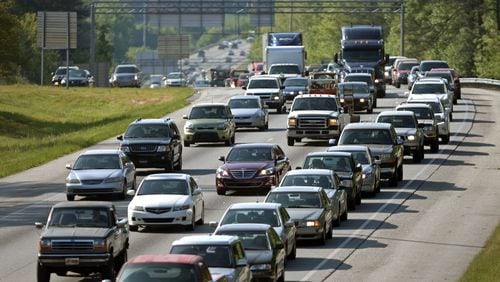The state Department of Transportation is updating its plan for optional toll lanes around metro Atlanta. At the moment, these projects are likely the next up, each of them to add new lanes, with the date the state hopes they will open to traffic:
- 2016: I-75 in Henry and Clayton County
- 2017: I-85 in Gwinnett County extended north from current HOT lane
- 2018: I-75/I-575 in Cobb and Cherokee counties
Source: DOT
The DOT is holding two open houses this week where people can hear and be heard about the I-75 Express Lanes project in Henry and Clayton Counties.
Tuesday, April 23
5 p.m. to 8 p.m.
Eagles Landing High School Commons
301 Tunis Road
McDonough, Ga. 30253
Thursday, April 25
5 p.m. to 8 p.m.
Hilton Garden Inn
95 Highway 81 West
McDonough, Ga. 30253
Georgia is about to construct its first new toll road since Ga. 400 and almost no one is talking about it.
Two counties away from the much-condemned I-85 HOT lane and the checkered, billion-dollar Northwest Corridor, 12.2 miles of I-75 mostly in Henry County is scheduled to sprout new lanes, to be the state’s first newly constructed toll road in two decades.
Public meetings Tuesday and Thursday launch the last chance for the public to have its say, and to learn about the pathbreaking project, before it goes out to bid in two months for design completion and construction.
The state Department of Transportation has held open houses, placed yard signs, gone door-to-door and met with local officials. But if interviews conducted for this article are any guide, the broader public either has not gotten the message, or isn’t exercised.
Tommy Smith has lived in Henry County for decades and just became chairman of its county commission. “I don’t know enough about the express lane project to form an opinion,” he said, “but if it’s something that could be added to Interstate 75 that gets people through here without a bottleneck, I’m all for it … Anything helps, if you get on a superslab.”
The project is among the most important the state will build in decades, since state officials hope it will reset public opinion on the principal plan for congestion relief in metro Atlanta: optional toll lanes.
Unlike the I-85 HOT lane between the Perimeter and Old Peachtree Road, with I-75 South taxpayers will get a new lane for their money. I-75 South is scheduled to be Georgia’s first optional toll road with new pavement to go under contract — and the first to open to traffic, in 2016. (Unlike the I-85 HOT lane, three-person carpools on the I-75 South toll lanes will not ride free.)
It will affect every Georgia taxpayer, since the tolls will not pay off the road’s construction; that’s being done by taxpayers, but they won’t be able to drive on the new lanes without paying the toll. DOT won’t know the job’s price until bids come in, but it was once estimated at $150 million.
The little attention paid so far to the I-75 toll lane is in contrast to the state’s history with other toll lanes. The I-85 HOT lane in Gwinnett County and Ga. 400 are all too famous, mostly for infuriating drivers with a toll they think shouldn’t be there. The I-75/I-575 Northwest Corridor project in Cobb and Cherokee counties has made national news as Georgia policymakers have stumbled and backtracked on it over nearly a decade.
The new project demonstrates a signature policy of Gov. Nathan Deal: He’s for toll lanes, but only those that build new pavement.
“I think that’s the difference” in public reaction to the Henry County project, Deal told the AJC last week. “As you know, I said that I would not approve in the future anything that converted an existing lane into a HOT lane.”
He added, “I do think it will be a success.”
DOT officials have no doubt.
“It’s an awesome thing,” said DOT’s deputy commissioner, Todd Long. “Everybody who’s ever traveled south of Atlanta on Saturday and Sunday knows it backs up for miles … you’re going to have people all over South Georgia getting Peach Passes.” All the region’s optional toll lanes will be electronically tolled, with sensors pinging “Peach Pass” transponders that drivers buy and place in their windows.
DOT’s efforts to publicize the project so far have reached a few hundred residents. Of those, more than a hundred offered opinions on the project. That’s not enough for a scientific survey, but in contrast to some other Georgia surveys that found overwhelming opposition to a toll project, majorities supported the one on I-75 South. With at least one exception: Unlike higher-income people, respondents making less than $25,000 overwhelmingly said that tolls were unfair.
In interviews this week, a number of residents said they’d never heard of the I-75 South project, while others echoed the survey responses.
Jim Everson, a crane operator who lives in Stockbridge, wasn’t aware of the project. When a reporter explained it to him, he said he was on board. “I’d use the express lane,” he said. “It’ll help traffic and really help during holidays and summers.” He travels I-75 South on the weekends to attend church and doesn’t mind paying a toll, though it depends on the amount.
McDonough resident John Koth agreed. He uses I-75 every weekday to get to his job at Auto-Chlor in Hapeville. He said he’s in favor of anything that will help ease the traffic congestion along the corridor.
On the other hand, a local blogger, McDonough resident Joanie Scott, wasn’t pleased.
Scott tries to stay well versed in Henry County happenings but didn’t know much about the I-75 express lane project. She uses I-75 to commute to her job near Hartsfield Airport but lives off of exit 218, past the toll lane entrance.
When told of some details of the project, she said it looked like a way to get out-of-state travelers quickly through the area and it wouldn’t do much to ease traffic for those in the county.
“My concern with that is that the long-distance travelers may not be aware of the rules,” she said. “As a commuter I don’t see where the benefit is for me.”
DOT officials hope building the lanes will drain traffic from the regular lanes — although history shows that building new lanes also draws new traffic to a highway.
The lanes will run in the center of the highway and be reversible. Northbound in the morning, they’ll start at Ga. 155 with one lane, and add a second lane at Ga. 20. At I-675 the toll lanes will branch and continue onto both I-75 and I-675, ending shortly after that split.
Unlike the I-85 HOT lane, drivers won’t be able to move back and forth between the regular interstate lanes and the toll lane except at the ends of the project. Northbound there will be a toll-only entrance from Jonesboro Road, and southbound it will exit onto Jonesboro Road.
An exit was originally planned at Mt. Carmel Road, but after public comment against it, that was canceled.
As on I-85, the toll price will rise and fall along with congestion in the main lanes, to keep out enough cars to keep the toll traffic flowing. That way, the state always has a tool to create one free-flowing space no matter how bad congestion gets.
It’s a compromise at DOT, which has come to the conclusion there will never be enough money to sufficiently widen all the region’s highways.
About the Author







